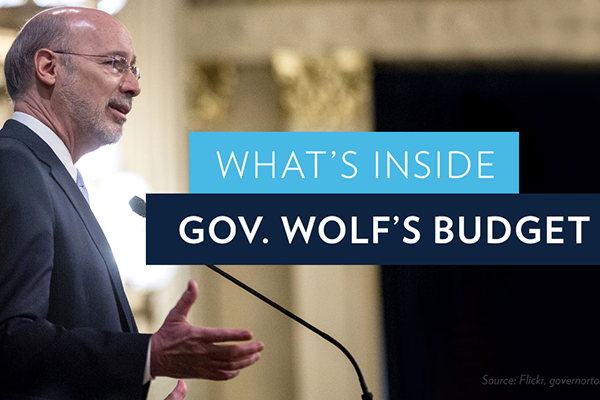Media

Five Things to Know about Gov. Wolf’s Proposed Budget
On February 6, Governor Wolf laid out his plan for the 2018-19 Pennsylvania state budget. Here are the five things you need to know:
1) Spending Increase Exceeds Taxpayer Protection Act Limit
- Gov. Wolf proposed a $33.0 billion General Fund Budget. This represents $991 million in new spending, an increase of 3.1 percent.
- The Taxpayer Protection Act, a version of which passed the House late last year, would limit spending growth to 1.32 percent (or $32.42 billion). By increasing spending more than families’ ability to pay, Gov. Wolf would force another tax increase this year or in the future.
- If passed, General Fund spending will have grown by $3.8 billion under Gov. Wolf.
2) Don’t Forget the Shadow Budget
- While the focus is on the $33 billion General Fund budget, the total operating budget presented by Gov. Wolf represents $84.7 billion, an increase of $3.3 billion over last year (or 4 percent). This “shadow budget” includes:
- Federal Funds: $29.6 billion (a $396 million increase).
- Special State Funds: $4.9 billion (a $235 million increase, or 5 percent).
- Other State Funds: $17.2 billion (a $1.6 billion increase, or a whopping 10.4 percent jump). This is the fastest growing part of state spending since 2000, caused in part by shifting funds off-budget to disguise the rate of growth.
- These totals don’t include the “capital budget,” or state borrowing. Gov. Wolf proposes another $1 billion borrowing this year, adding to the $12.5 billion in official state debt.
3) Wolf’s 11th Tax Hike Proposal
- Once again, Gov. Wolf proposed additional taxes on natural gas drillers, based on the myth that we don’t tax natural gas.
- Pennsylvania is the only state in the nation that taxes gas drillers with an “impact fee,” in addition to all other business taxes. If we truly want to “be like other gas-producing states,” we would eliminate our state income tax and corporate tax.
- Contrary to arguments that the gas isn’t going anywhere, and another tax will have no effect, industry jobs and investment are already leaving Pennsylvania. Since January 2015, Pennsylvania’s mining and logging sector lost more than 14,000 jobs.
- Since taking office, Gov. Wolf has introduced or supported eleven different tax hike proposals.
4) Gov. Wolf Proposes More Money for Public Schools, While Flatlining School Choice Programs
- Governor Wolf’s budget includes $606 million more for public schools, including a $100 million increase for basic education, but flatlines the Educational Improvement Tax Credit and Opportunity Scholarship Tax Credit.
- This proposed increase significantly exceeds the entire amount available through the EITC and OSTC, which provide scholarships to more than 50,000 students to attend the school of their choice at a fraction of the cost for traditional public schools.
- The EITC alone saved taxpayers $1 billion, according to an EdChoice audit.
- If Gov. Wolf truly wants to “make sure that your zip code doesn’t determine what kind of education you can get,” as he said in his speech, he should support expanding the EITC and creating Education Savings Accounts.
5) Wolf Doesn’t Address the Elephant in the Room: Welfare Costs
- Medical Assistance and Long-Term Care costs (i.e., Medicaid) will grow by $1.97 billion in Wolf’s budget, including $1 billion from other state funds. At $28.9 billion, this represents, by far, the biggest cost in the state’s operating budget.
- In other words, 33 cents of every tax dollar funds Medicaid. But these dollars aren’t always getting to those who truly need them.
- Reasonable work or volunteer requirements have been proven to help individuals gain job experience, escape poverty, and become self-sufficient.
- A work/community service provision for Medicaid would boost our economy and free limited resources for the disabled and elderly.
- 67% of Pennsylvania voters support work requirements for healthy adults in Medicaid, according to a November 2017 McLaughlin & Associates poll.